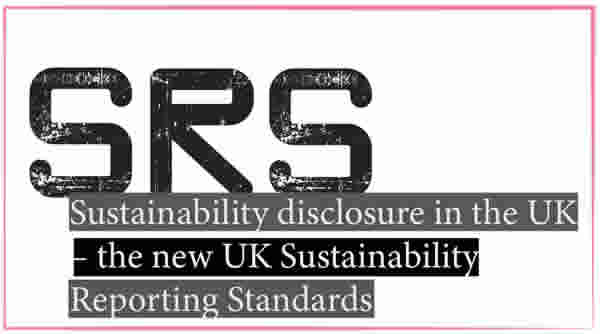Introduction
In June 2025 the UK Government released consultation drafts of its first two Sustainability Reporting Standards—UK SRS S1 and UK SRS S2—as part of its ambition to become a global leader in sustainable finance.
The proposed standards are not a whole new or radically different approach to sustainability disclosure. They are based closely on the International Sustainability Standards Board’s (ISSB) IFRS S1 and S2, with proposed UK-specific amendments.
This article presents a quick overview of the UK’s proposed approach and how they differ from the existing IFRS standards.

What is the background to the UK’s SRS consultation?
The draft SRS standards have been released in consultation form as the UK Government looks to assess whether and how the ISSB Standards should be used in the UK, and ultimately, to decide whether to endorse them.
While the UK Government has suggested some small amendments to the ISSB Standards to develop the draft UK SRS, their intention is to generate as little divergence as possible to ensure the comparability of international approaches to company reporting and the disclosure of sustainability information.
The consultation is open until 17 September 2025, and the government is inviting feedback from stakeholders.
How do the UK standards differ from IFRS standards?
The short answer is that they don’t differ very much. The UK Sustainability Reporting Standards (UK SRS) are closely aligned with the International Sustainability Standards Board (ISSB) frameworks—IFRS S1 and S2.
However, they include a few UK-specific modifications to reflect domestic priorities and regulatory context. The key differences are:
- Transition relief adjustments – the UK SRS removes the ISSB’s one-year transition relief for delayed sustainability reporting, requiring companies to report in sync with financial disclosures from the outset.
- Extended climate-first approach – the UK extends the optional ‘climate-first’ transition relief to two years, giving companies more time to phase in broader sustainability disclosures.
- Classification flexibility – unlike the ISSB, which mandates the use of the Global Industry Classification Standard (GICS), the UK SRS allows companies to use alternative classification systems.
- SASB references: – the UK softens the language around referencing SASB materials—from ‘shall refer to’ in ISSB to ‘may refer to’ in UK SRS.
- Carbon Credit and Scope 3 Emissions – the UK SRS introduces flexibility in how carbon credits are treated and allows companies to delay Scope 3 emissions reporting until the second year.
The scope of the SRS – what companies might need to use them?
At the time of writing, it appears that the UK Government is considering whether to require only listed companies to use the SRS, and for this requirement to be reflected by the UK FCA (Financial Conduct Authority) listing rules.
The government is also exploring the possibility of expanding the reach of the Standards by amending the Companies Act 2006. This would introduce sustainability disclosure obligations for economically significant entities that currently fall outside the Financial Conduct Authority’s regulatory scope, requiring them to report in line with the UK SRS.
Economically significant entities are those which operate in the finance, manufacturing, energy or retail sectors or they are large publicly or privately owned businesses.
Briefly, what are the SRS Standards?
Draft UK SRS S1 Standard
The Draft UK SRS S1 Standard focuses on general requirements for sustainability-related financial disclosures. It’s based on the ISSB’s IFRS S1 but includes UK-specific amendments to tailor the framework for domestic use.
In summary, the standard requires:
- 1) That companies provide clear, consistent, and comparable sustainability-related information that is connected to their financial reporting.
- 2) That entities need to disclose a core set of information, as follows:
- Governance – the systems, controls, and oversight mechanisms the entity applies to monitor and manage sustainability-related risks and opportunities.
- Strategy – how the entity plans for and responds to those risks and opportunities as part of its broader business strategy.
- Risk management – the methods used to identify, evaluate, prioritise, and track sustainability-related risks and opportunities.
- Metrics and targets – the entity’s performance on these matters, including progress toward any goals it has set or is legally obliged to achieve.
- Materiality is a critical lens that companies must use to drive their disclosure – to disclose material sustainability-related risks and opportunities over the short, medium, and long term. As with the ISSB standards though, a narrower scope of how a matter should be considered as material is used by both SRS and ISSB standards than the EU ESRS standards.
- The SRS considers that matters will be material if they have impacts or implications from an enterprise value perspective. Therefore, matters are considered to be material if omitting, misstating or obscuring information on them could reasonably be expected to influence decisions that primary users of general-purpose financial reports (predominantly investors and financial analysts) make on the basis of those reports.
Draft UK SRS S2 Standard
The Draft UK SRS S2 Standard outlines the UK’s proposed requirements for climate-related financial disclosures, adapting the ISSB’s IFRS S2 to the UK context. It is intended to ensure that companies disclose clear, consistent, and decision-useful information about climate-related risks and opportunities that could affect enterprise value.
Structure & Content
The standard is built around four core pillars (aligned with TCFD):
Governance – how an entity governs climate-related risks and opportunities by providing information on:
- Oversight by Governance Bodies – the structures, committees and individuals responsible for the management of climate impacts and performance intentions, How they incorporate climate risks into strategy, major decisions, and risk management and how they set and monitor climate-related targets, including links to executive compensation.
- Management’s role – who at management level is responsible and how their role is overseen and the internal controls and procedures in place for managing climate risks, and how these integrate with broader business functions.
Strategy – disclosure of how an entity’s strategy addresses climate-related risks and opportunities, including:
- Material Climate Risks and Opportunities – which might be reasonably expected to impact the entity’s future prospects.
- Impact on Business Model and Value Chain – current and anticipated effects on operations and relationships.
- Strategic and Decision-Making Implications – including details of the entity’s transition plan for addressing climate-related challenges.
- Financial Effects – how climate factors influence the entity’s financial position, performance, and cash flow now and over time (short, medium, long term), and how they’re reflected in financial planning.
- Climate Resilience – an assessment of how robust the entity’s strategy and business model are in the face of climate-related developments and uncertainties.
Risk Management – provide information and detail on how an entity manages climate-related risks and opportunities, and how these practices fit within its broader risk framework, including:
- Risk Processes – how climate-related risks are identified, assessed, prioritised and monitored.
- Opportunity identification and management – the methods used to identify, evaluate, prioritise, and monitor climate-related opportunities, including details on whether and how climate scenario analysis informs this process.
- Integration – how climate-related risk and opportunity processes are embedded into the entity’s overall risk management system.
Metrics & Targets – disclosure of GHG emissions (Scopes 1, 2, and 3), carbon credits, and climate targets, disclosing:
- Greenhouse gas emissions – Scope 1, 2, and 3 emissions, following the Greenhouse Gas (GHG) Protocol unless otherwise required.
- Risk and opportunity metrics – which quantify exposure to transition and physical risks.
Alignment with climate-related opportunities. - Capital expenditure, internal carbon pricing, and links to executive remuneration on climate matters.
- Industry-based metrics – additional metrics which are derived from agreed or standardised business models or sectors.
What are the implications of the SRS and what happens next?
Whilst the UK SRS are focused specifically upon the UK context, their content and approach will be familiar to companies that are either currently wrestling with or have successfully navigated the IFRS’ ISSB General and Climate-related disclosure standards.
This means that complying with the UK SRS (if they are issued) shouldn’t be a significant added burden to companies already (or planning to) report using existing IFRS standards, though they of course do differ in certain key respects from the EU’s ESRS.
The main additional implication, however, would be if the UK Government decides to expand the scope of companies required to disclose against the UK SRS beyond listed companies to privately held or otherwise significant businesses and organisations.
Finally, the UK SRS are out for consultation, it is currently unclear whether the Government will proceed to make them a requirement. This will depend not only on the nature, extent and type of consultation responses it receives, but also perhaps the wider context of global political sentiment, which is drifting away from additional requirements on business, and noticeably cooling on action aimed to address the escalating climate emergency.
Time will tell – but if you want to have your say (and if you can face it), read the consultation drafts and respond to the UK Government consultation!

 Coffee ads banned for misleading ‘compostable’ claims
Coffee ads banned for misleading ‘compostable’ claims
Leave a Reply